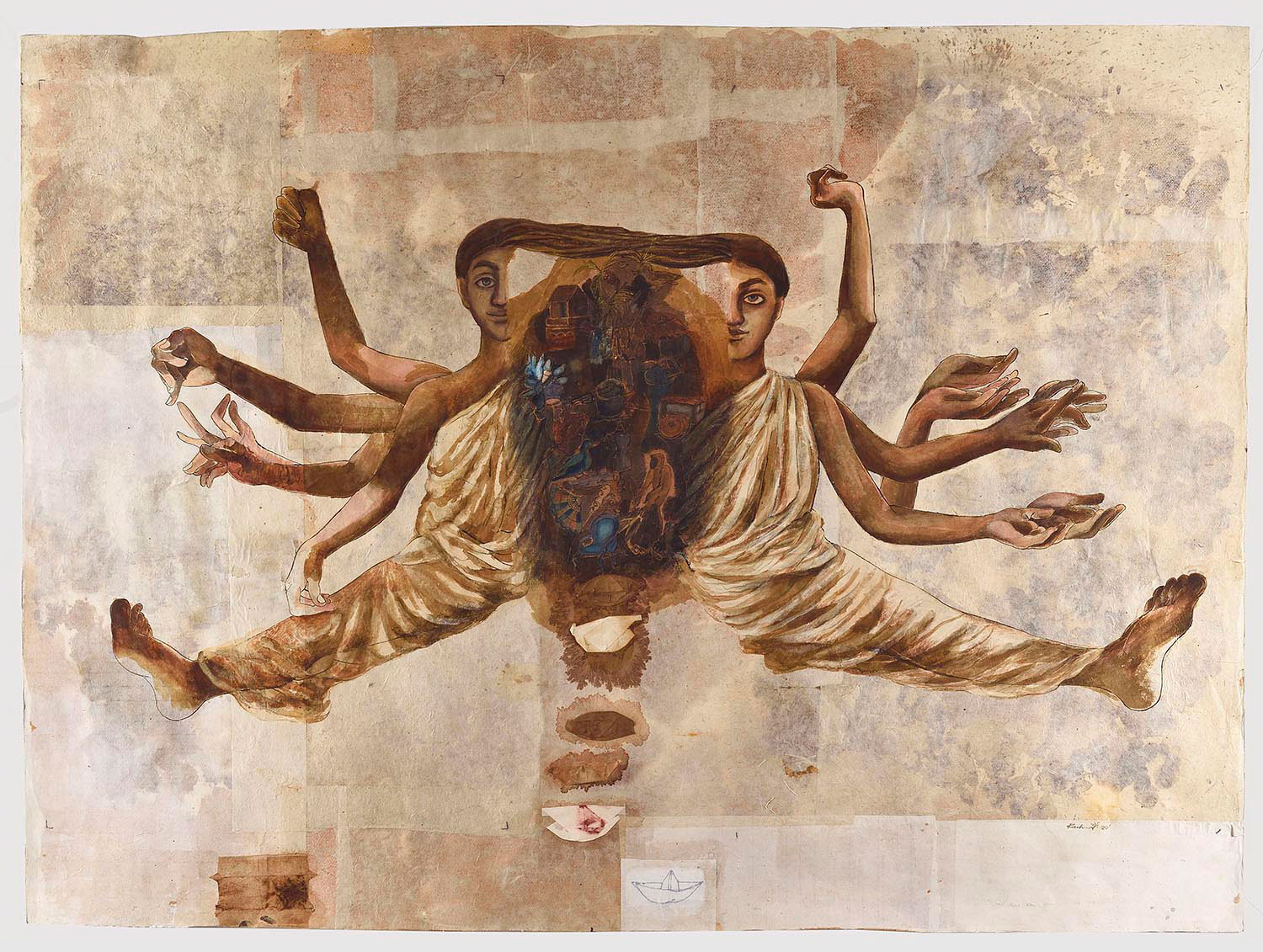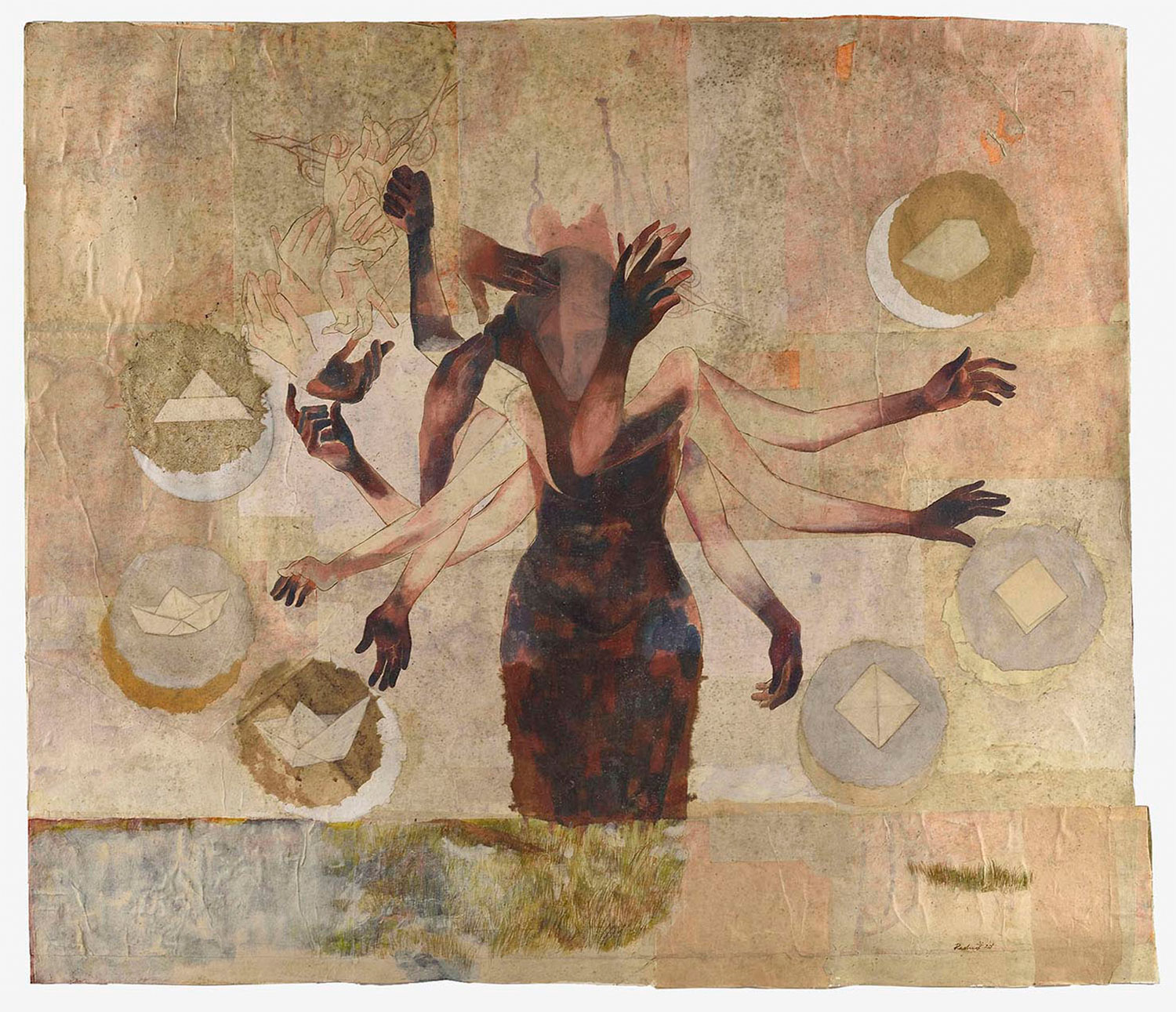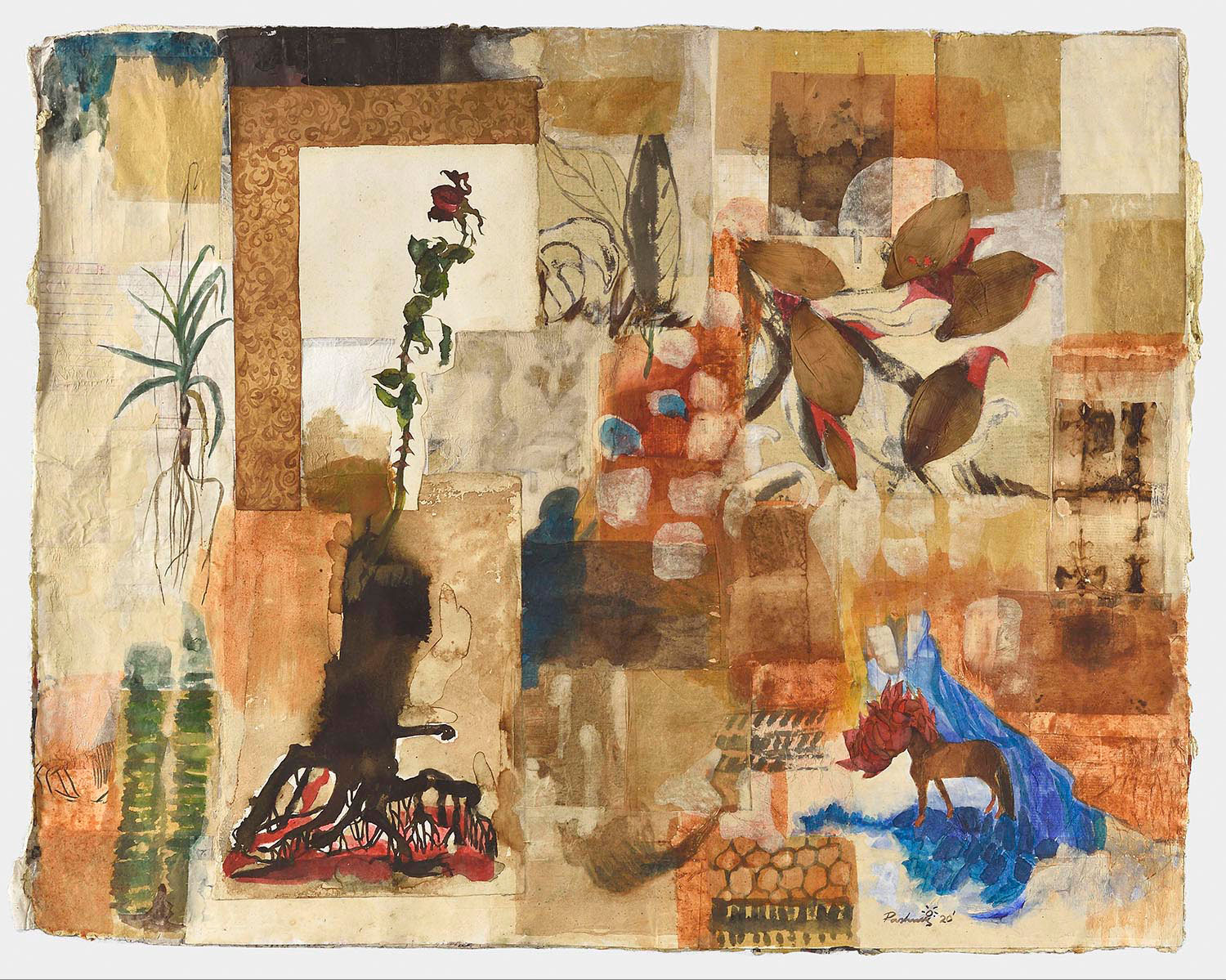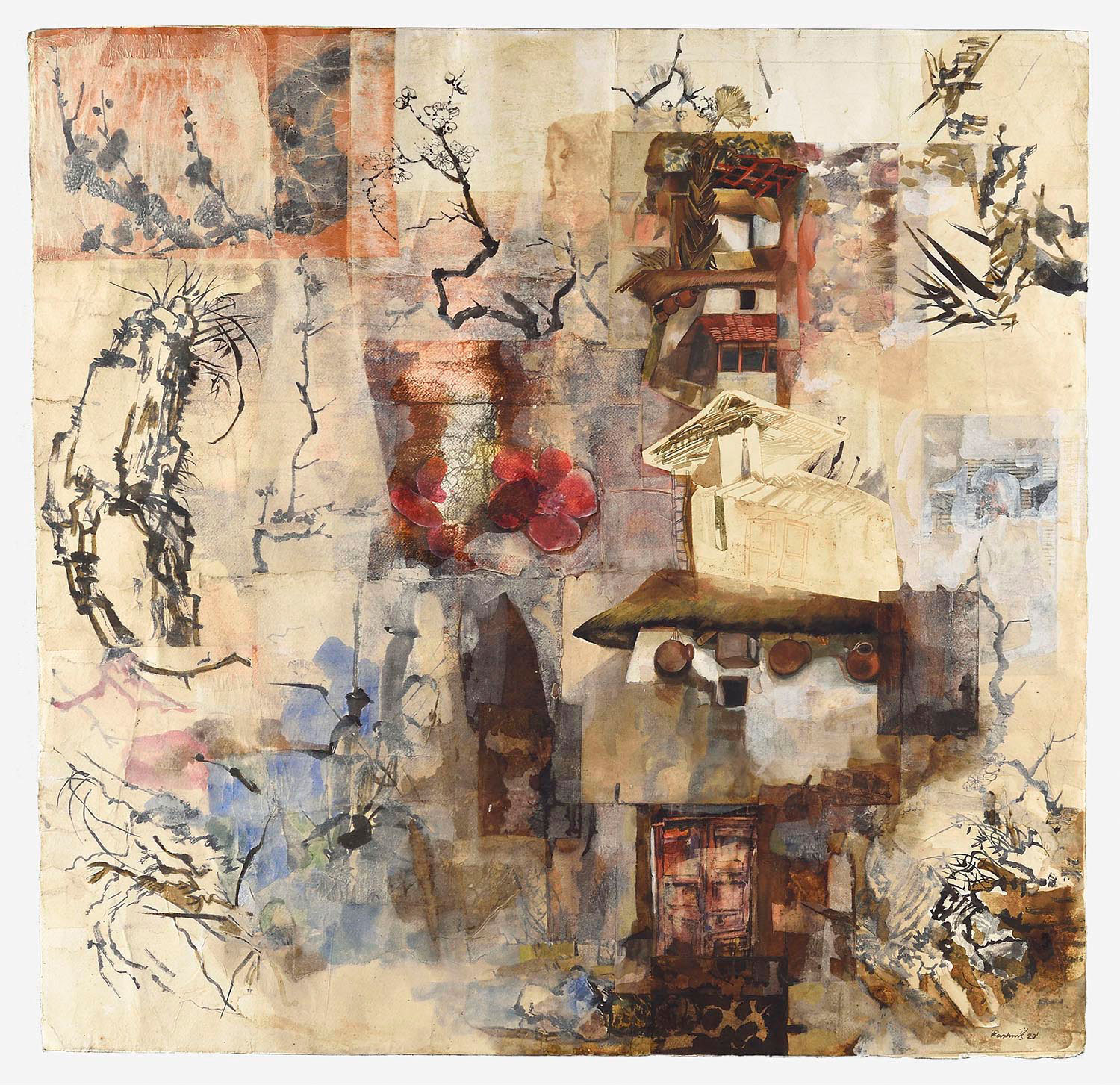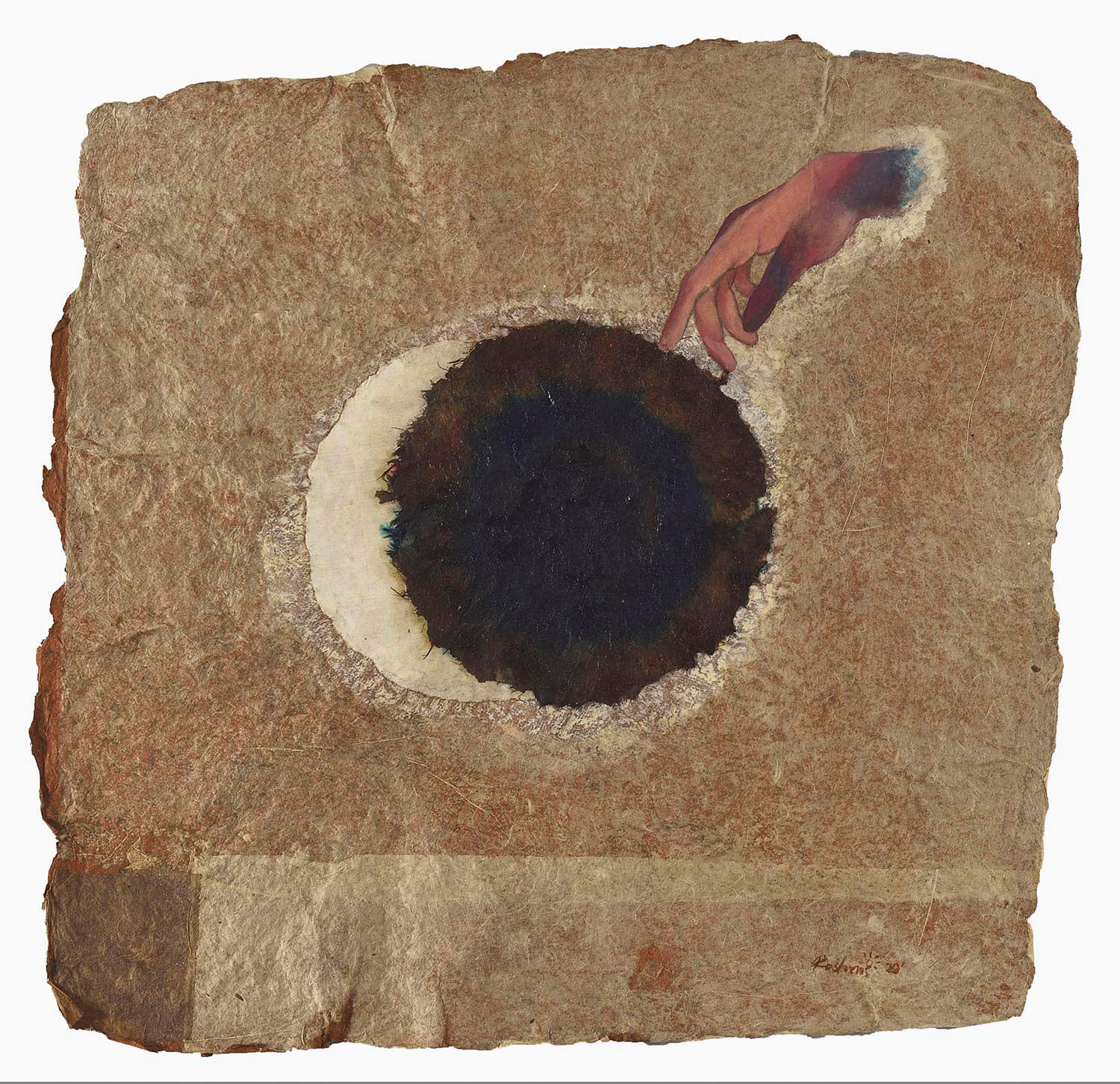
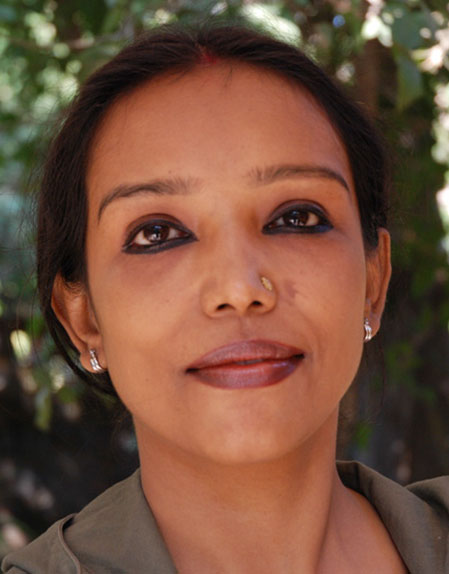
Rashmi Bagchi Sarkar
For Rashmi Bagchi Sarkar and Kingshuk Sarkar, the artist couple who have made Shantiniketan their home, the poetry of earth has inspired the philosophic anchor of their art in recent years. And it reflects the significant way in which chance gave way to choice.
An encounter with the Japanese nihonga technique early in their careers resulted in their allegiance to earth colours: paint made from semi-precious stones, shells, mineral ores, animal glue and the like. In fact, the whole ritual of making their own paint by pounding, straining, mixing is a kind of fervent tribute to Nature. It was, therefore, expected that their affair with the earth would embrace plants and natural fibres from which material such as paper can be made by hand.
This move away from consumer, off-the-shelf products quite naturally made the Sarkars increasingly aware of the local community of farmers and artisans, of agricultural produce and its waste and the crafts of the region: all of it a rich source for their art. Mining local traditions signals a commitment on two levels. On one runs a definite socio-economic tilt that resists mindless consumerism and the system that promotes it. On the other unfolds a search for a somewhat complex narrative of roots in which personal and family history plugs into the community ethos, nurturing a symbiotic interface.
Although her suite mostly appears gender-neutral, there’s just the hint of a feminine perspective in Rashmi Bagchi Sarkar’s idiom. Turning agricultural waste into paper refers both to the woman’s umbilical ties with the soil and its produce in her role of discovering farming; and with household management in recycling discards. This time around, Rashmi has also made use of the fine paper of tea bags and of tea stains, reminding the consumer of the labour of the nameless women who pluck the leaves and buds to fill the pots and pockets of others. Tea stains are increasingly popular with artists both for their delicate, seeping tints and the intimate messiness of domestic rituals they evoke. Besides, tea-making takes on a symbolic dimension because it distils the flavoured essence of leaves. These casual allusions coalesce into little recits as a sub-text in a grungy assemblage with rumpled, weathered, overlapping rectangles of paper made from agricultural waste that speaks of the garbage a consumer society dumps on the environment. And of rag-pickers who subsist on it.
In fact, a pattern of rectangles with different kinds of paper, most made from waste and natural fibre, keeps up a background hum in her present works. Pale and layered, with traces of shapes and faded doodling caught under, between or on the thin sheets, they seem to quest the chaotic archiving of experience in memory which eludes decoding by the waking mind. Smudgy flowers, wilted stems, lean leaves and twigs quoting East Asian landscapes and scraps of images, patterns and teary paints suggest a sensibility that’s introspective with an aching attachment to what evaporates from the conscious mind, inevitably.
While this set does have a feminine identity, it’s not pronounced. But her other set draws inspiration from women and their battle against the patriarchal prescriptions that keep them as pawns, playthings and punching bags. Rashmi is one of those who returns to the many-armed goddess of Hindu mythology as an icon representing the reality of the contemporary woman, particularly the Indian woman and the multiple roles she floats through as routine.
In one painting a woman sits with her legs spread-eagled, multiple arms radiating like Durga’s, fingers forming different gestures which echo dance mudras. She’s torn in two, as little motifs of her ambience intrude into her being, as it were. In another, her body is attenuated into a tattered rag of thin, mottled paint. But her arms are numerous, one of which sprouts a bouquet of elegant hands with tapering fingers that are as sprightly as wings but are ashen, withered and grounded, for they no longer belong to the body, to its volition, to the mind, but have been plucked out for chores designated by society. The suggestion of withering flowers and flightless birds comes naturally, not as feminist rhetoric. In fact, the visual riff of hands goes beyond feminine concerns to a wider, humanist symbolism: hands as an articulate tool, both for self- expression and for slavery. A tool that’s crafted civilization but is as vulnerable as it’s versatile.
Rita Datta,
Art Critic,
Kolkata, June 2020
Is it not the best time to acknowledge the fragility of human system? Does the word ‘be contemporary’ directly translate to urbanization? Is it not the time to acknowledge the capability of Art to provide solutions for critical problems which challenge our survival?
From ancient recorded history to the medieval period in India, a woman’s condition-socially, politically and economically has been ever evolving. In ancient India, women had an equal status to that of men; in the early Vedic period, they were very educated and there are references to women sages. Then there came a period when many discriminatory practices such as child marriage, devadashi pratha, sati pratha etc. became prevalent. Many Indian reformers tirelessly fought for women’s rights and made this country a better place for women. To have an idea of women’s struggle for status in India it is necessary to briefly survey how social changes have progressed from one form to another.
Being a woman I felt very connected with the many-handed Goddess, the concept and forms of Shakti, the divine cosmic energy. Mythological stories are of particular significance simply because they remind us as a society, of the boundless vigor and tenacity of woman. I understand myths as a means of engaging with the world by explaining its relevance and the role it plays in regulating our lives.
It has always been my opinion that artists should be responsible and conscious about basic human rights and wisdom. I have uncontrollably gravitated toward making art that is concerned with issues traditionally associated with male dominance, of tyranny, dictatorship, oppression and environmental injustice. Although I don’t consider myself an activist, I believe my art regardless of its nature, is an expression of protest, and a cry for humanity.
I fabricate my work of art with meticulous handmade details that contrast with the banality of their materials. By repurposing agricultural waste, handmade paper and waste paper, my work explores consumerism and detritus. Shredding and pulping these waste materials, breaks down their physical and ascribed composition so I can roll, fold, and articulate those into intimate shapes, forms and characters . Process, surface and texture reshape formulaic messages into forms based upon impressions from memory and observations. Conventional, impersonal messages become personal, domestic and cultural narratives.”
Rashmi Bagchi Sarkar
Santiniketan
4.8.2020
Click images for enlargement
Born: 1968
Education
2002-2003: Studied Japanese Calligraphy (Way of brush) and Sumi Painting, Saga University of Fine Arts, Kyoto,Japan
Study Tours to Meho Museum, Shiga Prefecture, Japan.
2001-2003: Studied Nihonga Style (Japanese Traditional) Painting and Techniques, Professor Kokyo Hatanaka’s Studio, Kyoto,Japan
1993: M.F.A. with a first class, Kala Bhavan, Visva Bharati University, Santiniketan
1990: B.F.A. with a first class, Kala Bhavan, Visva Bharati University, Santiniketan
Solo Exhibitions
1999: An Exhibition of Drawing and Painting, Nandan Gallery, Visva Bharati, Santiniketan
1996: An Exhibition of¬ Drawings, Gallery Ukil Dey, Santiniketan
Participations
2018:
RESPONSE-Installations & New Media – 25th Anniversary Show of CIMA Gallery, Kolkata, Gem Cinema, Kolkata
2017:
Studio Gem, Gem Cinema, Kolkata, organized by CIMA Gallery, Kolkata
2015:
Collateral project – CIMA gallery, Kolkata
2013-14:
Transition – 20th Anniversary Exhibition, CIMA Gallery, Kolkata
2012:
Summer Show 2012, CIMA Gallery, Kolkata
An Alternative Perspective, CIMA Gallery, Kolkata
2011-12:
Asian Artists, Exchange 2011, Kyoto City University of Arts Art Gallery, Kyoto; Kyungsung University of Art Museum, Korea; Victoria Memorial Hall, Kolkata; presented by Asian Artists Exchange Planning Committee and Kyoto City University of Arts, Japan and Kyung Sung University, Korea; supported by Nomura Foundation, The Kao Foundation for Arts and Sciences, Japan, Korea Cultural Foundation and others
2011:
Yeh Image Mahaan – India meets Bharat, Lalit Kala Akademi, New Delhi, organized by CIMA Gallery, Kolkata.
Summer Show 2011, CIMA Gallery, Kolkata
Art India Summit 2011, Pragati Maidan, New Delhi, represented through CIMA Gallery, Kolkata
2010:
Yeh Image Mahaan – India meets Bharat, CIMA Gallery, Kolkata
Symbols & Metaphors, CIMA Gallery, Kolkata
2009:
In Search of a Context, CIMA Gallery, Kolkata
Summer Show, CIMA Gallery, Kolkata
2008:
ReView, CIMA Gallery, Kolkata
Freedom : sixty years after Indian Independence, CIMA Gallery, Kolkata
Freedom : sixty years after Indian Independence, The Museum Gallery Mumbai, organized by CIMA Gallery, Kolkata
Summer Show, CIMA Gallery, Kolkata
2007:
Shifting Paradigms, Lalit Kala Akademi, New Delhi, organize by CIMA Gallery, Kolkata
2006-2007:
CIMA Annual 2006, CIMA Gallery, Kolkata
2006:
New Works, CIMA Gallery, Kolkata
2005:
Contemporary Forms – CIMA Annual Exhibition, CIMA Gallery, Kolkata
2004-2005:
47th National Exhibition of Art, Lalit Kala Akademi, New Delhi
2003:
Two Person, Taoraya Gallery. Kyoto,Japan
Living Myths – Earth and Fire, Gallery Mandara, Yamashina
Group Show, Gallery Machiya, Kyoto,Japan
Two Person Show, Kansai Seminar House, Kyoto,Japan
Group Show of Drawing & Painting, Event Hall, Kyoto,Japan
2002:
Selected young contemporaries from Santiniketan, Lalit Kala Akademi, New Delhi
2001:
Drawing & Paingting, Purna, Ratan Pally, Santiniketan
1999:
Tradition and Modernity in Bengal, Lalit Kala Akademi, New Delhi
Santiniketan Artists’ Exhibition, Bharatiya Gana Natya Sangha, Birbhum
1998:
Santiniketan Aesthetics Redefine, Birla Academy of Art & Culture, Mumbai
Young Santiniketan Today, Guild Art Gallery, Mumbai
Art Access Week – the Second, Birla Academy of Art & Culture, Mumbai
Paintings by Young Talents of Santiniketan, Gandhara Art Gallery, Kolkata
Annual Exhibition, Birla Academy of Art & Culture, Kolkata
An Exhibition by Kala Bhavan Students, Nandan Gallery, Santiniketan
1997:
Calcutta Metropolitan Festival of Art, Kolkata
1990:
Drawing and Painting Exhibition, Science Association Club, Kolkata

